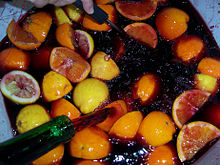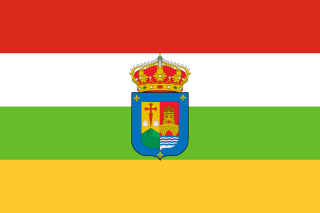
Rum and Coke, or the Cuba Libre, is a highball cocktail consisting of cola, rum, and in many recipes lime juice on ice. Traditionally, the cola ingredient is Coca-Cola ("Coke"), and the alcohol is a Cuban light rum such as Bacardi. However, the drink may be made with various types of rums and cola brands, and lime juice may or may not be included.

The piña colada is a sweet cocktail made with rum, coconut cream or coconut milk, and pineapple juice, usually served either blended or shaken with ice. It may be garnished with either a pineapple wedge, maraschino cherry, or both.

Mulled wine is a beverage usually made with red wine along with various mulling spices and sometimes raisins. It is served hot or warm and is alcoholic, although there are non-alcoholic versions of mulled wine. It is a traditional drink during winter, especially around Christmas.
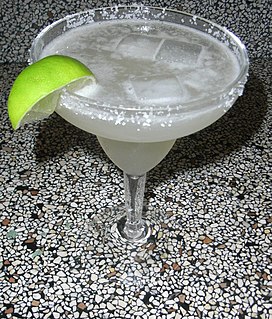
A margarita is a cocktail consisting of tequila, orange liqueur, and lime juice often served with salt on the rim of the glass. The drink is served shaken with ice, blended with ice, or without ice. Although it has become acceptable to serve a margarita in a wide variety of glass types, ranging from cocktail and wine glasses to pint glasses and even large schooners, the drink is traditionally served in the eponymous margarita glass, a stepped-diameter variant of a cocktail glass or champagne coupe.

Sangria is an alcoholic beverage. A punch, the sangria traditionally consists of red wine and chopped fruit, often with other ingredients such as orange juice or brandy.

In South and Central America, chicha is a fermented (alcoholic) or non-fermented beverage usually derived from grains, maize, or fruit., Chicha includes corn beer, known as chicha de jora, and non-alcoholic beverages such as chicha morada. Archaeobotanists have found evidence for chicha made from maize, the fruit of Schinus molle and Prosopis pods. Chichas can also be made from quinoa, kañiwa, peanut, manioc root, palm fruit, potato, Oxalis tuberosa, chañar or various other fruits.

The term punch refers to a wide assortment of drinks, both non-alcoholic and alcoholic, generally containing fruit or fruit juice. The drink was introduced from India to the United Kingdom in the early seventeenth century, and from there its use spread to other countries. Punch is typically served at parties in large, wide bowls, known as punch bowls.

Russian cuisine is a collection of the different cooking traditions of the Russian people. The cuisine is diverse, with Northern and Eastern European, Caucasian, Central Asian, Siberian, and East Asian influences. Russian cuisine derives its varied character from the vast and multi-ethnic expanse of Russia. Its foundations were laid by the peasant food of the rural population in an often harsh climate, with a combination of plentiful fish, pork, poultry, caviar, mushrooms, berries, and honey. Crops of rye, wheat, barley and millet provided the ingredients for a plethora of breads, pancakes, pies, cereals, beer and vodka. Soups and stews are centered on seasonal or storable produce, fish and meats. Such food remained the staple for the vast majority of Russians well into the 20th century. Soviet cuisine had a separate character of its own.
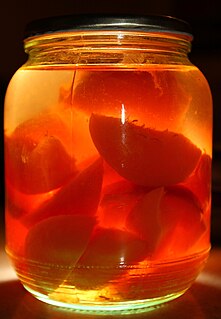
Kompot is a non-alcoholic sweet beverage of Slavic origin, that may be served hot or cold, depending on tradition and season. It is obtained by cooking fruit such as strawberries, apricots, peaches, apples, rhubarb, gooseberries, or sour cherries in a large volume of water, often together with sugar or raisins as additional sweeteners. Sometimes different spices such as vanilla or cinnamon are added for additional flavor, especially in winter when kompot is usually served hot.

Aguardiente is a generic term for alcoholic beverages that contain between 29% and 60% alcohol by volume. The word is a compound of the Romance languages' words for "water" and "burning(/fiery)", similarly to the English term "firewater". Both aguardiente and brandy—from the Dutch expression for "burnt wine"—originated as terms for distilled spirits using whatever ingredients were available locally.

Ti' Punch literally meaning "small punch," is a rum-based mixed drink that is especially popular in Martinique, Guadeloupe, Haiti, French Guiana and other French-speaking Caribbean islands. It is very similar to the daiquiri, which is usually identified with Cuba.

Colombian cuisine is a compound of the culinary traditions of the six main regions within the country. Colombian cuisine varies regionally and is particularly influenced by Indigenous, Spanish, and African cuisines, with slight Arab influence in some regions. Furthermore, Being one of the most biodiverse countries in the world, Colombia has one of the widest variety of aliments according to the microclimates of every region.
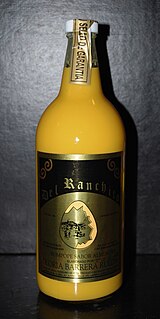
Rompope is an eggnog-like drink made with eggs, milk, and vanilla flavouring. The egg yolks impart a yellow hue to the emulsified beverage. It is a traditional drink known as such in Honduras Costa Rica, Ecuador, Nicaragua, El Salvador, Guatemala, Belize and particularly in Mexico, where, it is believed to have been originally made in the convents of the city of Puebla, Mexico. The word rompope is a derivation of the word rompon, which is used to describe the Spanish version of eggnog that came to Mexico. The Spanish version utilizes rum as its main ingredient, hence the root of both rom-pon and rom-pope, but in Central America, Guatemala, Honduras and El Salvador, there is also a similar beverage known as rompopo. For example, Salcaja, in Guatemala, offers one known version of this rompopo drink and in South America, the country of Chile has among its most popular drinks rompon and cola de mono or monkey’s tail, the latter containing coffee, making it dark instead of yellow, but also containing the other ingredients commonly found in rompope.
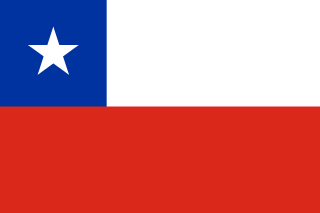
Chilean gastronomy stems mainly from the combination of traditional Spanish cuisine, Chilean Indigenous Mapuche culture and local ingredients, with later important influences from other European cuisines, particularly from Germany, Italy and France. The food tradition and recipes in Chile are notable for the variety of flavours and ingredients, with the country’s diverse geography and climate hosting a wide range of agricultural produce, fruits and vegetables. The long coastline and the peoples' relationship with the Pacific Ocean add an immense array of seafood products to Chilean cuisine, with the country's waters home to unique species of fish, molluscs, crustaceans and algae, thanks to the oxygen-rich water carried in by the Humboldt Current. Chile is also one of the world’s largest producers of wine and many Chilean recipes are enhanced and accompanied by local wines.
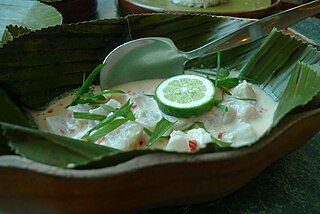
Kinilaw is a raw seafood dish native to the Philippines, similar to ceviche. It is more accurately a cooking process that relies on vinegar to denature the ingredients, rather than a dish, as it can also be used to prepare meat and vegetables. Meat-based kinilaw are more common in the northern Philippines and use blanched and lightly grilled meat. Kinilaw dishes are usually eaten as appetizers before a meal, or as finger food (pulutan) with alcoholic drinks.
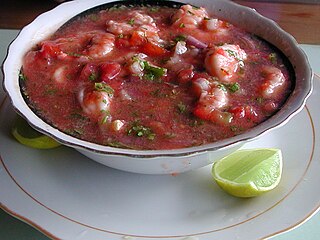
Ecuadorian cuisine is diverse, varying with altitude, and associated agricultural conditions. Beef, chicken, and seafood are popular in the coastal regions and are typically served with carbohydrate-rich foods, such as rice accompanied with lentils, pasta, or plantain. Whereas in the mountainous regions pork, chicken, beef and cuy are popular and are often served with rice, corn, or potatoes. A popular street food in mountainous regions is hornado, consisting of potatoes served with roasted pig. Some examples of Ecuadorian cuisine in general include patacones, llapingachos, and seco de chivo. A wide variety of fresh fruit is available, particularly at lower altitudes, including granadilla, passionfruit, naranjilla, several types of banana, uvilla, taxo, and tree tomato.

Oaxacan cuisine is a regional cuisine of Mexico, centered on the city of Oaxaca, the capital of the state of the same name located in southern Mexico. Oaxaca is one of Mexico's major gastronomic, historical, and gastro-historical centers whose cuisine is known internationally. Like the rest of Mexican cuisine, Oaxacan food is based on staples such as corn, beans and chile peppers, but there is a great variety of other ingredients and food preparations due to the influence of the state's varied geography and indigenous cultures. Corn and many beans were first cultivated in Oaxaca. Well known features of the cuisine include ingredients such as chocolate, Oaxaca cheese, mezcal and grasshoppers (chapulines) with dishes such as tlayudas, Oaxacan style tamales and seven notable varieties of mole sauce. The cuisine has been praised and promoted by food experts such as Diana Kennedy and Rick Bayless and is part of the state's appeal for tourists.
